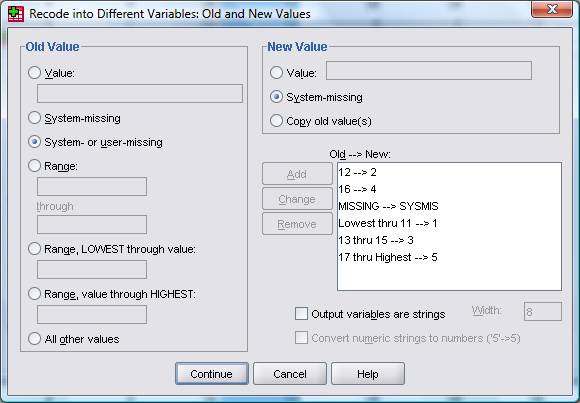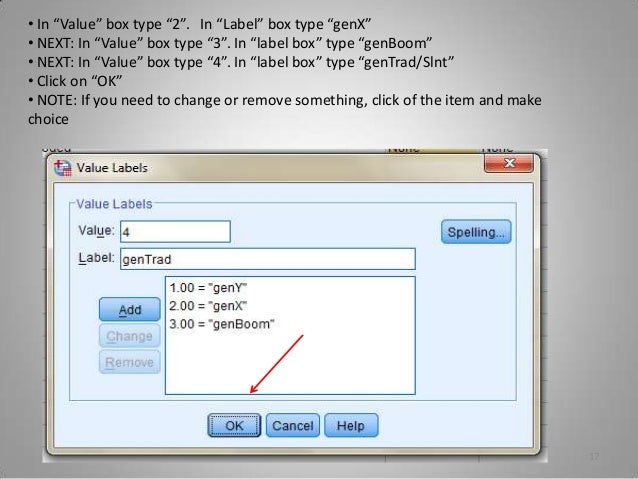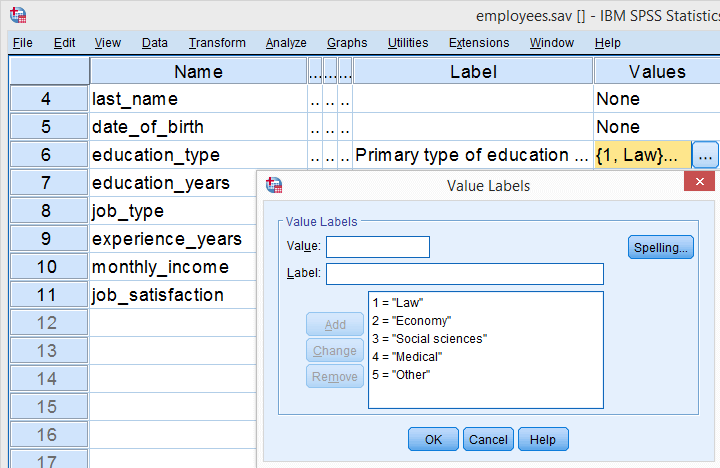45 spss value labels range
Recode Age Variable in SPSS - SlideShare 1) Type a new name for the variable, e.g. "age1" 2) Under label type "Age Recoded to Generational Groups" 3) Click on "Change" 4) Click on "Old and New Values" 5 6. This window will open. The two value buttons will be highlighted. Leave as is. The old value one will disappear after the subsequent choice. 6 7. a) Click on "Range". SPSS Variable and Value Labels: A Quick Tutorial - Alchemer VALUE LABELS / var503 TO var504 0 'Unchecked' 1 'Checked' / var603 TO var605 1 "Couldn't care less" 2 'Somewhat devoted' 3 "Can't live w/o it!" Hint: I typically like leaving the period on its own line. This gives me a nice, clear, visual reminder of where my command stops running.
Recoding Variables in SPSS Menus and Syntax - The Analysis Factor Old Value: Range: Lowest Through: 11. New Value: Value: 1. Click Add. ... I want to add the codes to spss as value lables and I also need to recode the existing data into 1,2,3,4,etc. ... you definitely want to use syntax to do both. The commands are RECODE and VALUE LABELS. If you look them up in the Command Syntax Reference manual. It's in ...

Spss value labels range
Missing Values User-defined missing values are specified via the Data Editor's Variable View, similar to specifying other variable attributes. Click on the cell under the Missing column. A button with an ellipsis ( ) appears. Click on this, and you'll be prompted to enter up to three missing values, or a range of missing values and optionally, one more value ... Using Syntax to Assign 'Variable Labels' and 'Value Labels' in SPSS Here are the steps to assign variable labels: Open a new syntax window by clicking through the following menu path ( see below ): File->New->Syntax. Type the command "VARIABLE LABELS" (be careful of spelling). On the next line (new line not required, but recommended), first type the name of the variable you want to assign a label to (in my ... SPSS Value and Labels - javatpoint SPSS Value and Labels In this section, we will learn the Values option. Values are used to indicate the Labels of variables. For example, if we have Gender as a variable, Gender has male and female labels.
Spss value labels range. Working with SPSS labels in R - GitHub Pages Running attr() whilst specifying "labels" shows that both methods of reading the SPSS file return variables that contain value label attributes. Note that specifying "labels" (with an s) typically returns value labels, whereas "label" (no s) would return the variable labels. Viewing value labels for data imported using haven: Defining Variables - SPSS Tutorials - Kent State University The Value Labels window appears. Type the first possible value (1) for your variable in the Value field. In the Label field type the label exactly as you want it to display (e.g., "Freshman"). Click Add when you are finished defining the value and label. Your variable value and label will appear in the center box. using recode function in SPSS with ranges - YouTube continuation of chapter 2 examples provided in Heck et al. (2014) text; illustrates use of ranges when recoding variables. Also, discusses recoding when you ... Defining Value Labels and Other Variable Properties Click the Unlabeled column heading under Scanned Variable List. You can also sort by variable name or measurement level by clicking the corresponding column heading under Scanned Variable List. Value Label Grid Label. Displays any value labels that have already been defined. You can add or change labels in this column. Value.
How To Find The Interquartile Range (IQR) In SPSS - Top Tip Bio To find the IQR in SPSS, simply follow the steps below. Firstly, in SPSS, go to ' Analyze > Descriptive Statistics > Explore '. This will open the ' Explore ' window. 2. In the ' Explore ' window, drag the variable of interest over to the ' Dependent List ' box. Finally, click the ' OK ' button. SPSS Class Notes: Modifying Data - IDRE Stats Into different variables... select total as the "input -> output variable" type grade as the output variable change click "old and new values" click on "range: lowest thru" and type 80 as the value and type 0 as the new value. click Add. click on "range" and continue to enter the values according the table below. Recoding Variables in SPSS Statistics - recoding a given range - Laerd Recode a given range in SPSS Statistics. Example: The data given below represents the scores of 10 students in a final examination. Recode the data giving code "1" to scores between 75 - 100, code 2 to scores between 61 - 74, code 3 to scores between 41 - 60 and code 4 to scores between 0 - 40. Final examination scores of 10 students. Scores. 58. Labeling and documenting data | SPSS Learning Modules You can use SPSS keywords such as lowest, lo, hi, highest and thru in specifying a range. You can use the sysfile info command, the display dictionary or the display labels command to see that the missing values were properly assigned. Because the missing values command is used to assign user-defined missing values, you cannot use a period (.).
Remove variable label, value labels and user defined missing values Remove variable label, value labels and user defined missing values Source: R/remove_labels.R The Values Column of the SPSS Variable View Tab - dummies The Values column in the SPSS Variable View tab is where you assign labels to all the possible values of a variable. If you select a cell in the Values column, a button with three dots appears. Clicking that button displays the dialog box shown here. /uploads/485341.image0.jpg" height="299" alt="You can assign a name to each possible value of a variable." SPSS - Set Variable Labels with Syntax SPSS Value Labels Syntax Examples (The test data used by the syntax below are found here .) *1. Apply single value label. Note how it appears under Variable View. value labels married 1 'Never married'. *2. Wrong way for adding/changing value labels. This removes the value label we added in the previous command. value labels married 2 'Married'. Display Value Labels in SPSS - Easy SPSS Tutorial Quick Steps Click on tab to display Variable View Identify your variable, click on its cell in the Values column, and then click on the ellipsis Enter your first coded numerical value where it says Value, and the label you want associated with that value where it says Label Press Add, and then repeat for all further numerical values
Value labels - ibm.com You can assign descriptive value labels for each value of a variable. This process is particularly useful if your data file uses numeric codes to represent non-numeric categories (for example, codes of 1 and 2 for male and female). Value labels are saved with the data file. You do not need to redefine value labels each time you open a data file.
Variable Labels and Value Labels in SPSS - The Analysis Factor The really nice part is SPSS makes Variable Labels easy to use: 1. Mouse over the variable name in the Data View spreadsheet to see the Variable Label. 2. In dialog boxes, lists of variables can be shown with either Variable Names or Variable Labels. Just go to Edit->Options. In the General tab, choose Display Labels.
Recoding Variables in SPSS Statistics - Laerd How to recode variables in SPSS Statistics, specifically, recoding data into two categories. Login. ... Enter the value of "5" into the Range, ... from 8 to 16 also, so that the string labels are not truncated. Published with written permission from SPSS Statistics, IBM Corporation. Click on the button. Enter the value of "6" into the ...
for loop - SPSS/Python - Accessing variable labels - Stack Overflow I am trying to access variable labels in for loop in SPSS using Python. The for loop iterates over a range of variables, deleting 1-3 and renaming 4 and 5 in a sequence of 5 variables. This works fine, but now when trying to access the variable labels via SPSS I am running into the 'unicode object has no attribute keyes' error.
How to Transform (Recode) Variables in SPSS - bizkapish In new dialog user will enter three discrete values (3), or combination of one range and one discrete value (4). Invalid values will not be specially labeled in "Data view", but rows with such values will be excluded from any further analysis by the SPSS. This is explained in the blog post .
SPSS RANGE Function - Simple Tutorial with Examples SPSS ' RANGE function is used to evaluate whether or not values are within a given range. Test values equal to the lower or upper boundary are also within the given range. Run the syntax below for a quick demonstration. SPSS Range Syntax Example *1. Create couple of cases. data list free/v1 (f1). begin data 1 2 3 4 5 6 end data. *2.
Copy variable and value labels and SPSS-style missing value This function copies variable and value labels (including missing values) from one vector to another or from one data frame to another data frame. For data frame, labels are copied according to variable names, and only if variables are the same type in both data frames.
Recoding Variables - SPSS Tutorials - Kent State University Old and New Values. Once you click Old and New Values, a new window where you will specify how to transform the values will appear.. 1 Old Value: Specify the type of value you wish to recode (e.g., a specific value, missing data, or a range of values) and the specific value to be recoded (e.g., a value of "1" or a range of "1-5").. When recoding variables, always handle the missing ...
How to show the numeric values of categorical labels in output using ... In SPSS you can choose in the settings wether label, the numerical values or both are shown in the output tables. GUI. In the Menu choose Edit->Options and then the Output tab. There you can change the output settings under Pivot Table Labeling. Syntax. Within Syntax Editor you can define the output settings with the "SET TNUMBERS" command.
Value Labels - SPSS - YouTube Using both the menu driven approach as well as syntax, I demonstrate how to create value labels for variables in SPSS.
SPSS Value and Labels - javatpoint SPSS Value and Labels In this section, we will learn the Values option. Values are used to indicate the Labels of variables. For example, if we have Gender as a variable, Gender has male and female labels.
Using Syntax to Assign 'Variable Labels' and 'Value Labels' in SPSS Here are the steps to assign variable labels: Open a new syntax window by clicking through the following menu path ( see below ): File->New->Syntax. Type the command "VARIABLE LABELS" (be careful of spelling). On the next line (new line not required, but recommended), first type the name of the variable you want to assign a label to (in my ...
Missing Values User-defined missing values are specified via the Data Editor's Variable View, similar to specifying other variable attributes. Click on the cell under the Missing column. A button with an ellipsis ( ) appears. Click on this, and you'll be prompted to enter up to three missing values, or a range of missing values and optionally, one more value ...













Post a Comment for "45 spss value labels range"